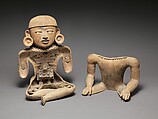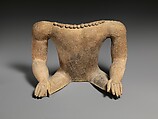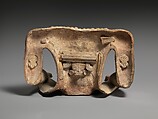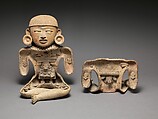Host figure
This sculpture in the shape of a seated cross-legged male with his hands on his knees has a removable chest plate that reveals mold-made figurines and medallions attached to the inside of the body. The main individual is not dressed, with the exception of a large collar (composed of circular appliques) and large earflares. Traces of red pigment indicate that it was once brightly painted and its eyes were inlaid with pyrite, traces of which still remain. He wears a distinct hairstyle, incised in a crisp row of bangs that frame the face and a longer portion that falls to his shoulders in the back. Inside the upper leg lie prone two figures, while a larger figure stands in the cavity of the torso. This interior figure wears a large butterfly headdress, containing two feathered eyes and a curled proboscis motif, an abstract butterfly-shaped nose ornament, and a large collar composed of u-shaped elements. These forms might represent a necklace of human maxillae, which have been found with sacrificed warriors in archaeological excavations. The removable chest plate also has the head of a figure with a butterfly nose ornament that faces off with the larger version in the body.
This composition comes from the Pacific Coast region of Guatemala. The style of this work, known as a "host" figure, connects it to the great Mexican city of Teotihuacan—a site nearly seven hundred miles northwest—where this type of hollow figure is thought to have originated. Host figures may have been deployed in intimate ritual activities, with the interior figurines revealed at certain moments. Such figures may speak to ancient Mesoamerican ideas of personhood and the divine, hinting at beliefs that there was an essence that resided inside humans, be they ancestors, deities, or natural forces.
Further Reading
Architectural Digest (June 1981), cover; p. 106.
Berjonneau, Gerald, Emile Deletaille, and Jean-Louis Sonnery. Rediscovered Masterpieces of Mesoamerica: Mexico-Guatemala-Honduras. Boulogne: Editions Arts 135, 1985, no. 153, p. 118.
Berrin, Kathleen, and Esther Pasztory, eds. Teotihuacan: Art from the City of the Gods. New York and San Francisco: Thames & Hudson Inc., 1993, no. 66, pp. 214–215.
Hellmuth, Nicholas M. The Escuintla Hoards: Teotihuacan Art in Guatemala. F.L.A.A.R. Progress Reports, Vol. vol. 1, no. 2. Guatemala City: Foundation for Latin American Anthropological Research, 1975, p. 58, Plate 42A-B.
LaGamma, Alisa, Joanne Pillsbury, Yaëlle Biro, and James Doyle. "Recent Acquisitions: A Selection: 2014–2016." The Metropolitan Museum of Art Bulletin (Fall 2016), p. 16.
Ferber, Andrea L., Ph.D. "Collections: The Metropolitan Museum of Art." First American Art no. 23 (Summer 2019), p. 101.
#1633. Host Figure
This image cannot be enlarged, viewed at full screen, or downloaded.
This artwork is meant to be viewed from right to left. Scroll left to view more.










